August 2016
August 18, 2016
Hop’n Gator Beer
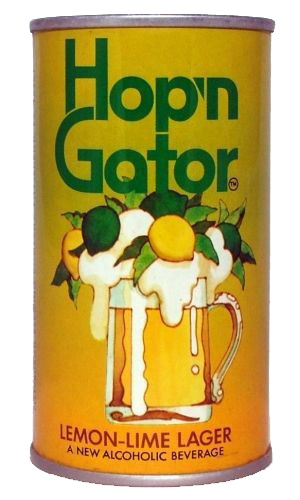
In 1969, the Pittsburgh Brewing Company introduced Hop'n Gator Lemon-Lime Lager, which was a combination of beer and Gatorade, but with 25% more alcohol than regular beer. The concoction was created by Robert Cade, the inventor of Gatorade.
A comment on BeerAdvocate.com provides some insight about what might have been going through the minds of the management team at the brewery when they decided to come out with this product:
However, Hop'n Gator quickly ran into problems. First, the brewery was sued in 1970 by the makers of Gatorade for infringing on the Gatorade trademark. This suit apparently was settled. But the larger problem was that Hop'n Gator, pitched to the public as a "lemon-lime lager," just didn't sell very well.
So the brewery dropped the "lemon-lime lager" description and re-introduced Hop'n Gator as a "tropical-flavored malt liquor." This proved more appealing, especially among blacks in Georgia, South Carolina, and Detroit. So much so that the beverage attracted the attention of the NAACP. As reported in the Charleston Post and Courier:
In 1975, the Pittsburgh Brewing Company gave up and discontinued Hop 'n' Gator. In 2004, they produced 10,000 more barrels of it as a novelty. But no more since. So unless you can find some on eBay, your chance of ever trying Hop'n Gator is gone.
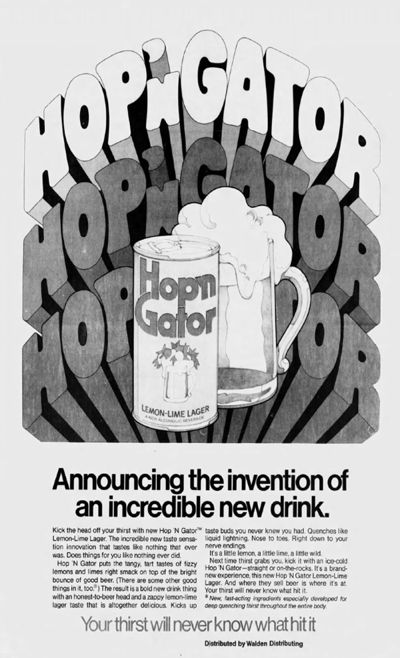
And one more bit of Gatorade-related trivia. In a 2001 interview with Sports Illustrated, Robert Cade revealed that when the University of Florida Gators were first testing Gatorade, some of the players had complained that it tasted like urine. So Cade and an assistant tested the hypothesis and concluded that, in fact, "There's a significant difference in flavor."
Posted By: Alex - Thu Aug 18, 2016 -
Comments (3)
Category:
Tanlac
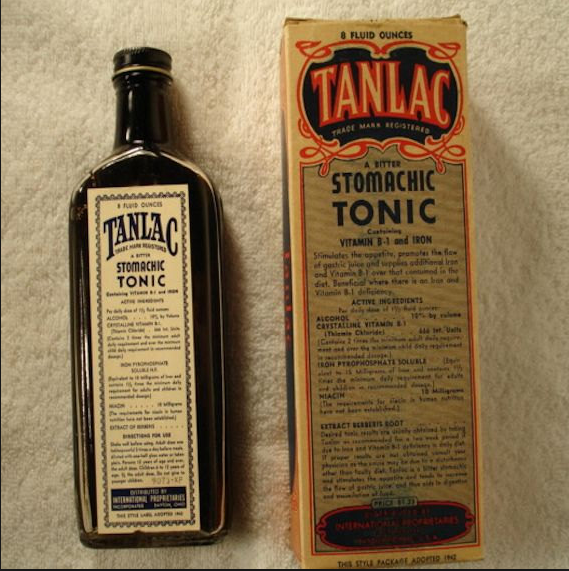
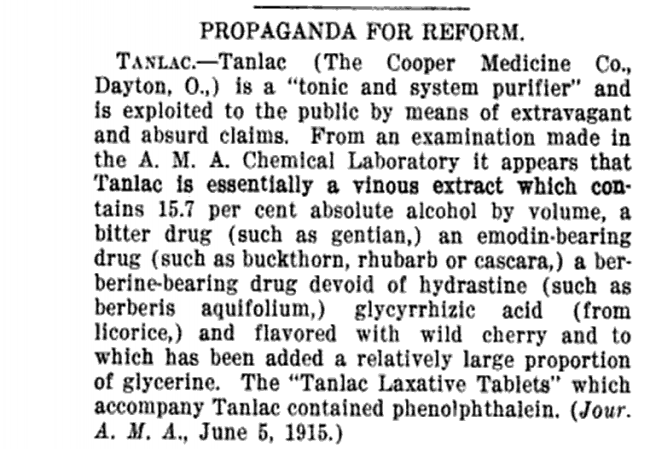
Original text here.
Despite this 1915 revelation of fraud, Tanlac continued to sell for at least another 30 years. The bottle in the picture dates from 1942.
Maybe it was due to ads like this one.
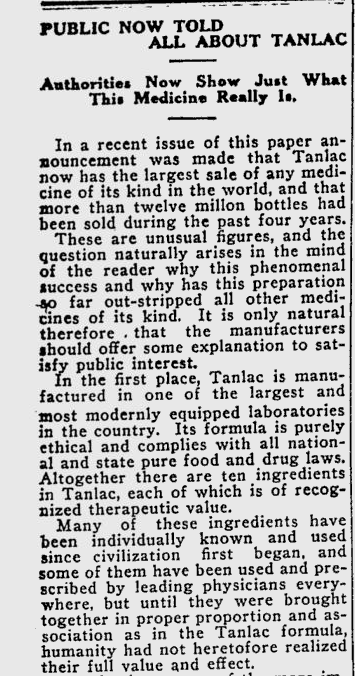
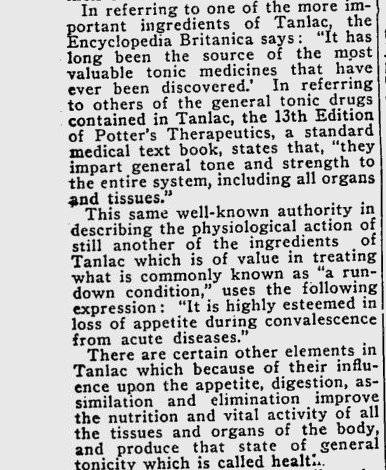
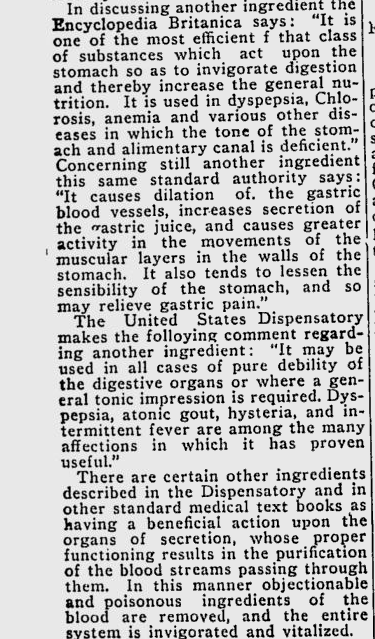
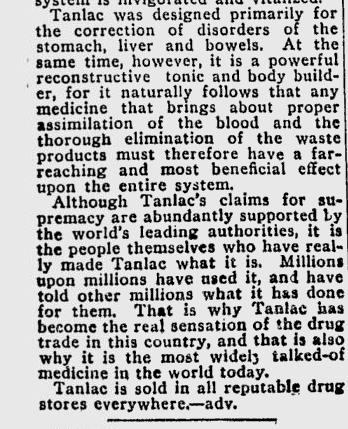
Original ad here.
Posted By: Paul - Thu Aug 18, 2016 -
Comments (2)
Category: Patent Medicines, Nostrums and Snake Oil, 1910s, 1940s
August 17, 2016
Da-Dum… Da-Dum… Da-Dum

Researchers at UC San Diego (my grad school alma mater) have published research documenting that the "ominous background music that often accompanies shark footage" can cause people to view sharks in a negative light, whereas the same footage set to "uplifting background music" doesn't have this effect.
They note that their study is the first "to demonstrate empirically that the connotative attributes of background music accompanying shark footage affect viewers’ attitudes toward sharks."
Posted By: Alex - Wed Aug 17, 2016 -
Comments (4)
Category: Animals, Fish, Documentaries
Happy
Wikipedia article here.
Another, lesser-known, candidate for "Worst TV Show Ever." As a critic said at the time:
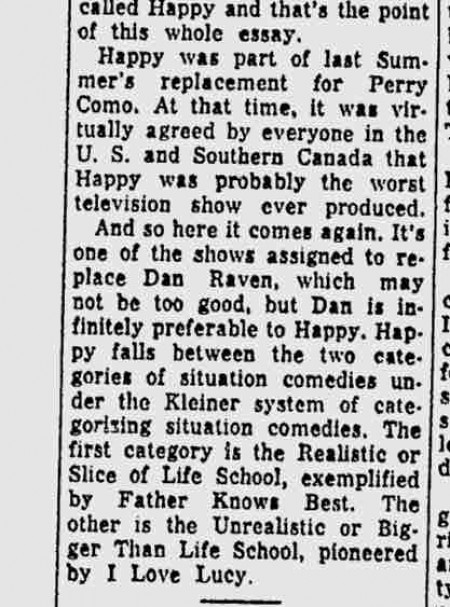
Posted By: Paul - Wed Aug 17, 2016 -
Comments (3)
Category: Television, Babies and Toddlers, Fantasy, 1960s
August 16, 2016
Byron Randall, collector of potato mashers

Byron Randall (1918-1999) was an American West Coast artist, but he also received recognition as a collector of potato mashers.
He told a UPI reporter in 1984 that he started his collection not because of any special connection to potato mashers, but simply because he wanted to have a "unique collection." But he gave a more detailed explanation of the origin of his hobby in an interview with Wesley Joost and Jon Randall:
Randall also admitted that he didn't like potatoes themselves — just the mashers.
As of 1984, he had collected 384 mashers. I don't know how many he owned by the time he died. But he claimed that this was the biggest collection of potato mashers in the world.
The Idaho Potato Museum also has a large potato masher collection, which they acquired as a result of a Boy Scout's Eagle Project. So I emailed them to ask how big their collection is. A representative (Tish Dahmen) responded that they have "280 mashers on display then another box full."
She reckons that Randall's collection was larger, and unfortunately she has no idea what became of his mashers. But she added: "if you discover its whereabouts, please know that we’d be happy to house and exhibit it if his family or estate wants to donate to us … we will be happy to accept it!"
Finding a permanent home for a potato masher collection seems like a worthy project, so I'm working on it. There was once a Byron Randall Museum in Tomales, CA, where Randall lived and ran a bed-and-breakfast. Perhaps the museum acquired his collection. However, the museum doesn't have a website. So I don't know if it's still in existence.
I've contacted the Tomales Regional History Center to ask if they know where Randall's potato mashers are.

Idaho Potato Museum Masher Collection — via California or Bust!

Milwaukee Sentinel - May 4, 1984

The Pittsburgh Press - May 3, 1984
Posted By: Alex - Tue Aug 16, 2016 -
Comments (6)
Category: Hobbies and DIY, Collectors
Miss World 1969
Dig those beehive 'do's!
Posted By: Paul - Tue Aug 16, 2016 -
Comments (4)
Category: Beauty, Ugliness and Other Aesthetic Issues, Contests, Races and Other Competitions, 1960s
August 15, 2016
Treating Tuberculosis with Sunlight
In a medical reference book from the 1940s, The New People's Physician (1941), I came across these pictures of kids in classrooms and playing sports dressed only in their tighty-whities. They weren't students at a clothing-optional school. They were actually being treated for tuberculosis. In the days before antibiotics, sunlight therapy (or heliotherapy) was a popular cure for that disease.
"At Leysin, in the Alpes Vaudoises, Dr. A. Rollier instituted the treatment of pulmonary tuberculosis and other tuberculous diseases by means of direct sunlight. The patients spend as much time as possible in the open air, exposed to the rays of the sun."
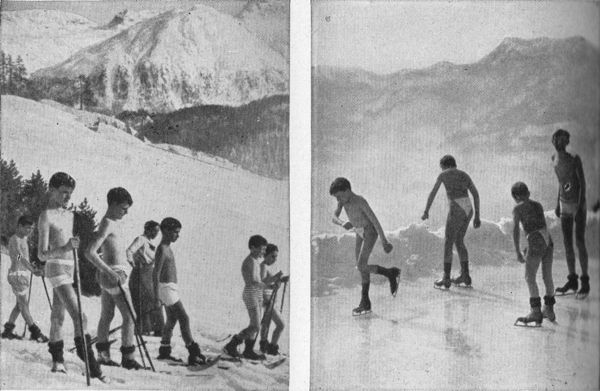
"Early cases of tuberculosis in young and vigorous people benefit considerably from treatment at high altitudes. Exercise and sport of a not too strenuous nature is advocated."
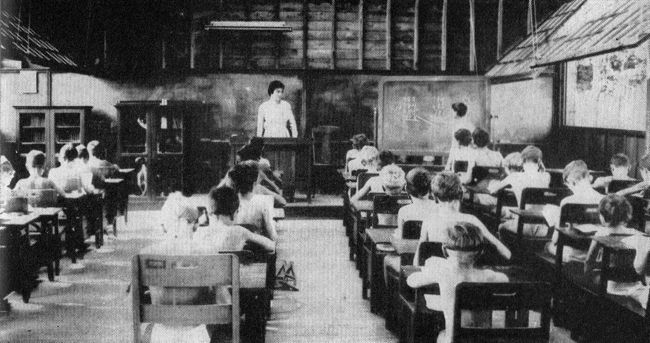
"At Perrysburg, N.Y., tubercular children study in an open-air schoolroom, stripped to the waist."
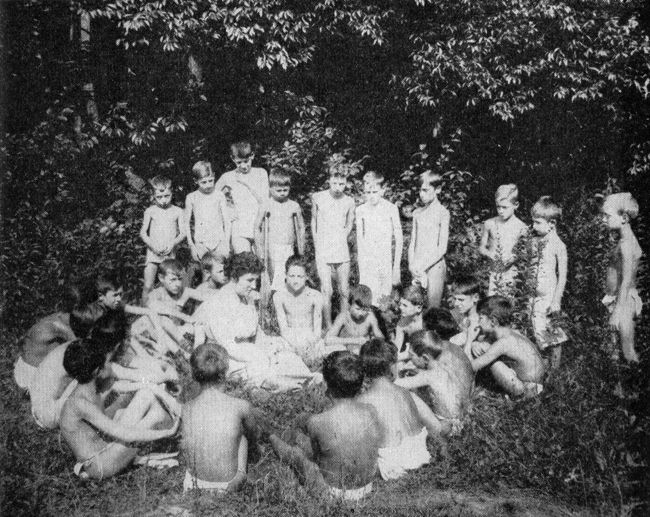
"Minimum clothing and maximum exposure to the sun contribute to improving the health of these tuberculous children at Perrysburg, New York. Outdoor classes and fresh air improve general health as well."
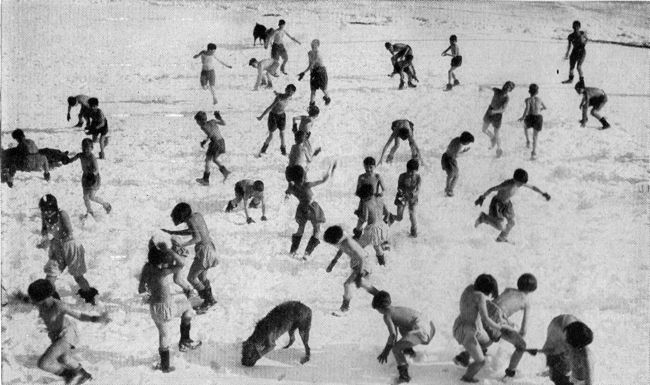
"Outdoor air and sunlight, even in the New England winter, are part of the treatment for child tuberculosis patients of the Meriden State Tuberculosis Sanitarium, Meriden, Conn."
An LA Times article (May 28, 2007) gives some background on the popularity of sunlight therapy for TB:
Rollier devised a detailed protocol for how, exactly, to sunbathe for health. He was convinced that early-morning sun was best and that sun exposure was most beneficial when the air was cool. When patients, most of whom had tuberculosis, arrived at his solaria, they first had to adjust to the altitude (his clinics were in the mountains) and then to the cool air. Once acclimated, Rollier slowly exposed them to the sun.
The patients were rolled onto sun-drenched, open-air balconies, wearing loincloths and covered from head to toe with white sheets. On the first day of treatment, just their feet peeked out from under the sheets, and only for five minutes. On day two, the sheets were pulled a little higher, and the patients were left in the sun a few minutes more. By day five, only the patients' heads were covered, their bodies left to soak up sun for more than an hour. After a few weeks, the patients were very tan -- and hopefully very healthy. (The therapy worked for many, but not all.)
And according to a fairly recent article in the Journal of Cell Biology, "Curing TB with Sunlight" (Mar 27, 2006), sunlight actually is a fairly effective treatment for tuberculosis:
The finding may explain why Hermann Brehmer's 19th century trip to the Himalayas cured him of his TB, and why the fresh air at his sanatoria helped cure others. “Our forefathers knew a lot more about this than we give them credit for,” says Modlin. Eventually, however, sanitoria coddled their patients behind glass, which would have blocked the beneficial UV light.
Posted By: Alex - Mon Aug 15, 2016 -
Comments (2)
Category: Medicine, Diseases
Jill Day’s Gym
I call total sexual harassment on Jill Day. Luckily she could fall back on her singing.
Note how these poor oppressed men in the second video have retreated to a female-free gym.
Posted By: Paul - Mon Aug 15, 2016 -
Comments (2)
Category: Music, 1950s, 1960s, Europe, Bodybuilding
August 14, 2016
Alligators Climb Trees!

Gators can climb trees, who knew?!?
Posted By: Alex - Sun Aug 14, 2016 -
Comments (3)
Category: Animals, More Things To Worry About
News of the Weird (August 14, 2016)
News of the WeirdWeirdnuz.M488, August 14, 2016
Copyright 2016 by Chuck Shepherd. All rights reserved.
Lead Story
The late fashion designer Alexander McQueen (who dabbled in macabre collections, himself), might appreciate the work of acolyte Tina Gorjanc: She will grow McQueen's skin (from DNA off his hair) in a lab, add back his tattoos, and from that make leather handbags and jackets. Gorjanc, a recent graduate of McQueen's fashion school alma mater, bills the project mainly as showcasing the meager legal protections for abandoned bits of human DNA--and fears industrial use of such DNA on a much larger scale. [Quartz, 7-16-2016]
War Is Hell
(1) Jihadists had a rough year militarily and now suffer further from an array of field reports (such as a new book by retired Lt. Gen. Michael Flynn) that their most sensitive laptop computers captured in battle by U.S. forces seemed always to be loaded with pornography--including "vile" material involving kids and animals. (Initially, said one analyst, there was so much porn that U.S. intelligence figured its purpose was only to disguise tactical messages within the sex-scene pixels.) (2) On the other hand, jihadists can claim one victory, in that the actor Michael Caine said recently the terrorist-caused airport discomforts had finally convinced him to legally change his name to "Michael Caine"--after tiring of explaining to screeners why he had Maurice Micklewhite's (his birth name's) passport. [ABC News, 7-14-2016] [The Guardian, 7-22-2016]
Awkward Flirtations
For Some Reason, Ladies Turned Them Down: (1) Patrick Marsh, 59, was charged with indecent exposure in Woodward Township, Pa., in July after he rang the doorbell of a 30-year-old female neighbor seeking, as he told police, "courtship." He greeted the woman naked, "with his genitals in his hands." (2) In Florida's The Villages senior community, Howard Sparber, 69, faces several charges after having, in June, fired 33 9mm rounds into the home of a woman who had been declining his sexual overtures. (The lady was away.) (3) John Taylor, 57, said he was just lonely and wanted to meet women when a court sentenced him in Shirley, England, in July, for a three-month spree of furtively slipping men's underwear through various women's house letterboxes. [PennLive.com, 7-12-2016] [WKMG-TV (Orlando), 6-21-2016] [Birmingham Mail, 7-26-2016]
Compelling Explanations
In June, Dieter Uchtdorf, a high official in the Mormon Church, said the historic narrative of Mormon founder Joseph Smith's use of a "seer stone" to translate the "golden plates" that gave Smith ultimate worldly knowledge has been authenticated, basically, by the 2007 invention of the iPhone. "I can get the collected knowledge of the world through a few little inputs," said Uchtdorf, and thus it is likelier than ever that God gave Smith something like a smartphone in 1823. [LDS Daily (Salt Lake City), 6-21-2016]
Geoffrey Fortier, 23, was arrested in Craighead County, Ark., in July and charged with video voyeurism of a woman he had allowed to shower in the home occupied by Fortier and his girlfriend. After the woman stepped out of the shower, she noticed a logged-on iPad propped against a wall. Fortier informed deputies that it was all a misunderstanding--that he had earlier recorded himself urinating in order to sell the video to a urination-fetish website, and he simply forgot to remove the device. [Arkansas Online, 7-28-2016]
Scientific Breakthroughs
Friendly Bacteria: Plastics are well-known to decompose slowly, but the most difficult is the polyethylene used for containers such as the omnipresent water bottles, and despite recycling, tens of millions of metric tons wind up in landfills, where the plastic's strong polymer bonds resist breakdown. Recently, however, two Japanese researchers, after tedious trial-and-error, identified a bacterium that views the "polyethylene terephthalate" as an efficient, tasty meal. A colleague of the two said further tweaking was necessary before using the bacteria industrially. [Chemical & Engineering News, 3-11-2016]
Room-Sized Bong? Samuel Oliphant, 35, was arrested on various charges in Scottsdale, Ariz., in June after police were called to a house to investigate a "strong and unusual" odor (which cops suspected to be drugs). Inside, they found a "laboratory," necessitating their "hazmat protocols," because Oliphant had allegedly built a "complex and elaborate" system apparently for the purpose of enhancing the smoking of marijuana. [KPHO-TV (Phoenix), 7-1-2016]
Awesome!
Rapper Kasper Knight apparently shot himself in the cheek with a revolver on July 17th in Indianapolis--as part of a staged music video--according to a raw footage of the incident posted on his Facebook page (and then of course seen by almost two million people). Knight, seen bleeding afterward, said he tried to recruit a shooter, but when no one volunteered, shot himself, anticipating (as in previous times he had been shot, by other people) "like a 4 out of 10 on the pain scale." [WRTV (Indianapolis), 7-27-2016]
The Passing Parade
(1) The Belton (Tex.) Early Childhood (pre-kindergarten) School staged an "Enchanted Evening" prom in May and posted many photos on its Facebook page of little toddlers arrayed in tuxedos, gowns, corsages, and of course, for some, limousines. (A Kansas City Star reporter suggested that this was just the beginning of an expensive parental trend.) (2) The village of Trecon was inducted recently into the club of French towns with silly names. "Tres con," translated, is "very stupid." Mayor Georges Leherle accepted the 39th-town membership, joining incumbent members including "Monteton" ("My Nipple") and "Mariol" ("Dumbass"). [Kansas City Star, 6-27-2016] [The Local (Paris), 7-11-2016]
Least Competent Criminals
Didn't Quite Think It Through: The man who tried an armed carjacking at the Oasis car wash in Shreveport, La., on July 20th was sent running by the car owner Michael Davis, who was holding a high-pressure hose at the time and casually directed the stream to the potential thief's face while swinging the metal wand at him. [KSLA-TV (Shreveport, 7-25-2016]
Recurring Themes
Things That Have Happened Before: (1) An ambulance was called in July when jockey Chris Meehan was kicked in the face by a horse and knocked out cold after he fell during a race in Merano, Italy, but the arriving ambulance accidentally backed over his leg. He is recovering. (2) At England's premier agricultural event ("Great Yorkshire"), a winning show cow was stripped of her title, suspected of having artificially "enhanced" udders. The runner-up, of course, was promoted. [The Racing Post via Daily Telegraph (London), 7-5-2016] [The Northern Echo (Wycombe, England), 7-14-2016]
The Classic Middle Name (All New!)
Arrested Recently and Charged with Murder: Cody Wayne Fish (Norman, Okla., August); Curtis Wayne Trexler (Salisbury, N.C., July); Daryl Royston Wayne Cook (Hobart, Australia, July); James Wayne Rodgers Jr. (Dallas, Tex., May); Bruce Wayne Cameron (St. Louis County, Minn., June 2015). Fugitive Murder Arrest Warrant Issued: Vernon Wayne King (Harrisburg, Pa., August). Pleaded Guilty to Murder: Stacy Wayne Brown (Wilmington, N.C., July). Sentenced for Murder: Christopher Wayne Hill (Harlan County, Ky., June) (a different Christopher Wayne Hill than reported years ago in News of the Weird). Killed Himself Resisting Arrest for Murder: David Wayne Campbell (Mason County, Wash., February). Granted New Sentencing Hearing: convicted murderer Michael Wayne Norris (Houston, Tex., June). Committed Suicide in Prison: convicted murderer Flint Wayne Harrison (Farmington, Utah, July). Executed for Murder: John Wayne Conner (Jackson, Ga., July).
[Fish: Norman Transcript, 8-1-2016]
[Trexler: WXII-TV (Greensboro), 7-19-2016]
[Cook: The Mercury (Hobart), 7-24-2016]
[Rodgers: Dallas Morning News, 5-10-2016]
[Cameron: Duluth NewsTribune, 6-2-2016]
[King: WPMT-TV (Harrisburg), 8-2-2016]
[Brown: WWAY-TV (Wilmington), 7-18-2016]
[Hill: Harlan Daily Enterprise, 6-2-2016]
[Campbell: Associated Press via Seattle Times, 2-27-2016]
[Norris: Associated Press via YourHoustonNews.com, 6-22-2016]
[Harrison: GephardtDaily.com (Salt Lake City), 7-25-2016]
[Conner: Atlanta Journal-Constitution, 7-15-2016]
A News of the Weird Classic (September 2012)
“Pheromone parties” attract men and women seeking romance not via often-insincere conversation but based on the primal-scent signals emitted by each other's slept-in t-shirts. Organizers have staged parties in New York City and Los Angeles and plan to expand, according to a June [2012] Associated Press report. The organizers' initial conclusion: People prefer lovers with a somewhat-different genetic makeup than their own, but not too different. (Update: "Pheromone parties" were attracting attention as recently as 2014 but not much since then.) [Associated Press via USA Today, 6-23-2012] [The Atlantic, August 2014]
Thanks This Week to Frederick Fisher, Eric Lindinger, Chris Bailey, Robert Skinner, and Mr. & Mrs. "Ted" Henderson, and to the News of the Weird Board of Editorial Advisors.
Posted By: Chuck - Sun Aug 14, 2016 -
Comments (3)
Category:
| Get WU Posts by Email | |
|---|---|

| Who We Are |
|---|
| Alex Boese Alex is the creator and curator of the Museum of Hoaxes. He's also the author of various weird, non-fiction books such as Elephants on Acid. Paul Di Filippo Paul has been paid to put weird ideas into fictional form for over thirty years, in his career as a noted science fiction writer. He has recently begun blogging on many curious topics with three fellow writers at The Inferior 4+1. Chuck Shepherd Chuck is the purveyor of News of the Weird, the syndicated column which for decades has set the gold-standard for reporting on oddities and the bizarre. Our banner was drawn by the legendary underground cartoonist Rick Altergott. Contact Us |

